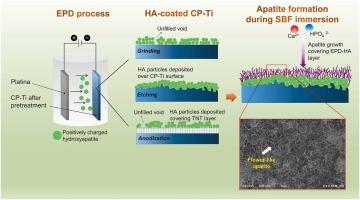提升钛植入物性能:通过表面预处理技术的对比分析优化羟基磷灰石电泳沉积
IF 6.3
2区 材料科学
Q2 CHEMISTRY, PHYSICAL
引用次数: 0
摘要
利用电泳沉积(EPD)技术成功地将羟基磷灰石(HA)涂覆在商业纯钛(CP-Ti)上,以提高钛在骨科植入物中的生物活性。本工作研究了表面预处理,包括研磨、蚀刻和阳极氧化,对HA涂层性能的影响。每一种预处理都改变了CP-Ti的形貌和表面粗糙度,蚀刻获得了最高的表面粗糙度(Sa = 1.88µm)。此外,SEM分析证实,蚀刻产生了具有凹凸结构的粗糙表面,从而导致更有组织和更密集的HA沉积。相反,阳极氧化和研磨导致涂层不均匀,多孔。所有ha涂层的样品都表现出改善的亲水性,这意味着增强的生物活性,阳极处理的样品达到最低的接触角(2.2°)。在模拟体液(SBF)中的腐蚀测试显示,ha涂层样品的腐蚀电位(Ecorr)增加,对腐蚀电流密度(icorr)的影响最小。此外,阳极处理后的样品由于其氧化层而表现出最高的耐腐蚀性。浸渍后测试显示,羟基磷灰石涂层上形成了花状磷灰石晶体。这些结果表明,无论采用何种预处理技术,应用epd的HA涂层都能显著提高CP-Ti的生物活性。值得注意的是,蚀刻预处理导致了更好的骨整合,Ca/P比为1.70的均匀花状磷灰石证明了这一点,与HA相非常相似。本文章由计算机程序翻译,如有差异,请以英文原文为准。

Advancing titanium implant performance: Optimizing hydroxyapatite electrophoretic deposition through comparative analysis of surface pretreatment techniques
Hydroxyapatite (HA) was successfully coated on commercially pure titanium (CP-Ti) using the electrophoretic deposition (EPD) technique to enhance titanium's bioactivity for orthopedic implants. This work investigated the impact of surface pretreatments, including grinding, etching, and anodization, on the HA coating's properties. Each pretreatment modified the CP-Ti's topography and surface roughness, with etching achieving the highest surface roughness (Sa = 1.88 µm). Moreover, SEM analysis verified that etching created a rough surface with a concavity structure, leading to more organized and denser HA deposition. In contrast, anodization and grinding resulted in uneven, porous coatings. All HA-coated samples displayed improved hydrophilicity, implying enhanced bioactivity, with the anodized sample achieving the lowest contact angle (2.2°). Corrosion tests in simulated body fluid (SBF) revealed increased corrosion potential (Ecorr) in HA-coated samples, with minimal impact on corrosion current density (icorr). Furthermore, the anodized sample showed the highest corrosion resistance due to its oxide layer. Post-immersion tests demonstrated flower-like apatite crystal formation on the HA coating. These findings suggest that EPD-applied HA coatings significantly improve the bioactivity of CP-Ti, regardless of the various applied pretreatment techniques. Remarkably, etching pretreatment resulted in superior osteointegration, as evidenced by the homogeneous flower-like apatite with a Ca/P ratio of 1.70, closely resembling the HA phase.
求助全文
通过发布文献求助,成功后即可免费获取论文全文。
去求助
来源期刊

Journal of Alloys and Compounds
工程技术-材料科学:综合
CiteScore
11.10
自引率
14.50%
发文量
5146
审稿时长
67 days
期刊介绍:
The Journal of Alloys and Compounds is intended to serve as an international medium for the publication of work on solid materials comprising compounds as well as alloys. Its great strength lies in the diversity of discipline which it encompasses, drawing together results from materials science, solid-state chemistry and physics.
 求助内容:
求助内容: 应助结果提醒方式:
应助结果提醒方式:


